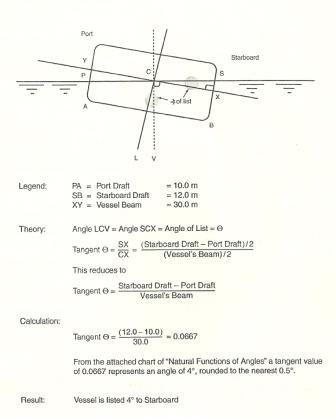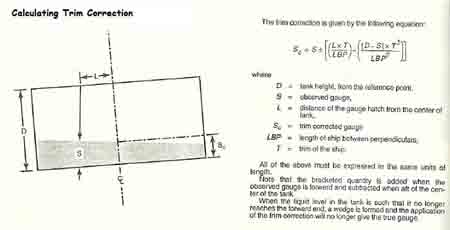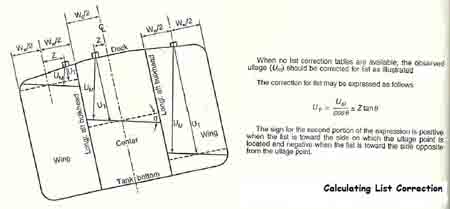|

TRIM AND LIST CORRECTIONS
When a vessel is not on even
keel at the time of gauging, the vessel's trim or list must be taken
into account to accurately determine the liquid volumes on
board. To do so, the instructions found in the vessel's
trim/list tables must be followed to make the required adjustments for
any trim or list noted. If the vessel does not have such trim
or list tables, a note to that effect should be made on the ullage
report.
When the trim and list tables are not available, a
calculated adjustment to the observed ship tank measurements should be
made if the relative vessel and tank dimensions are known.


Lightering, Single-Buoy Mooring
(SBM), and Other Offshore Activities
Offshore
measurements should generally be performed in the same manner as
measurements at the dock. For the purposes of VEF calculations,
loadings from and discharges to SBMs, SPMs, sea-docks, etc. are to be
considered shore operations even though they are conducted
offshore. Lighterings are considered ship-to-ship
transfers. In many instances, lightering will take place
between
a large tank vessel and one or more smaller vessels. To
ensure
that all of the material is accounted for, measurements are required on
all vessels before and after each transfer.
Adverse
Weather Conditions
Adverse weather will affect
personnel
safety, marine measurements, and gauging accuracy when the following
conditions arise:
-
High
winds and heavy seas and swells will present problems in gauging
accuracy if they cause the vessel to roll or pitch. These can
be
offset by appropriate attention being paid to gauging the oil in motion
in the tanks.
-
Any
type of precipitation encountered during the measurement/sampling
process must be dealt with very carefully. Water-indicating
paste
should be protected from activation by rain, atmospheric humidity, or
moisture on the gauge bob or bar or the tape. Sample containers should
be kept clean and dry, and care should be taken so no rain or other
external moisture is introduced to the containers.
-
Extremes
in atmospheric temperature require special consideration
during measurement because of possible reaction of the cargo
involved. For example, high air or water temperatures can
lead to
vaporization of cargoes whereas cold water or air temperatures could
lead to solidification and higher ROBs of high-pour-point cargoes.
Alternate
Procedures for Measurement of Small Quantities
ALTERNATE
FREE WATER MEASUREMENT
When using an interface
detecting PMU, water- finding paste may be placed on the outside of the
probe before lowering it to the tank bottom. When a clean
strike of the tank bottom is felt, allow the probe to remain in the
tank a sufficient amount of time for any water present to react with
the paste. Normally 30-60 seconds will be required but more time might
be necessary for heavier oils. After the required reaction
time, retrieve the probe without hesitation and measure the cut on the
probe using a calibrated tape. This is the innage of the
water in the tank being measured.
The free-water ullage obtained
by using the PMU can then be converted to a calculated innage by
subtracting the ullage from the published reference height.
Compare the innage obtained by using water-paste to the calculated
innage and record both readings if they are different.
BRASS
BOB PMU-WATER MEASUREMENT
The traditional brass bob and
water-finding paste method can be used through a VCV by using a
specially designed PMU. This equipment allows the bob to be
attached to the end of it. It then may be lowered into the
tank like the usual PMU equipment, but when the procedure is used it is
then like the procedure described in API MPMS Chapter 17 .2.4
BRASS BOB PMU-ROB/OBQ MEASUREMENT
The traditional brass bob
gauging method can be used through a VCV by using a specially designed
PMU. This equipment allows the bob to be attached to the end of
it. It then may be lowered into the tank like the usual PMU
equipment.
Size
and Location of Vapor Control Valves
The size and location of the
vapor control valves used for closed or restricted system measurement
are critical to the process. A VCV of the proper size,
located correctly, will allow more accurate measurements to be taken
than one improperly located and of insufficient size. For the
best way to measure OBQ/ROB and free water under most operating
conditions, the VCV must allow access to the tank as far aft as
possible and still allow the gauge tape to be lowered to the bottom of
the vessel's tank without touching the aft bulkhead during extreme trim
at stem conditions. When the VCV is located in the middle of
a tank, it usually will be impossible to measure any free water or
OBQ/ROB under normal operating conditions.
It may be noted that to take
sufficient samples and accurate measurements of small quantities and
free water when the vessel is not on an even keel. a VCV must be
located as close as possible to the aft bulkhead or to the bulkhead
toward the direction of the vessel's normal operating trim and Iist.
Operating
Temperature Ranges of PMUs
Each PMU has a
designed operating range of temperatures above or below which the units
may not function accurately. It is necessary to know the
correct operating limits of the equipment used so that the designed
measurement parameters are not exceeded in the field. Only a
PMU with a designed operating range suited for the temperature and
gravity of the cargo being measured should be used for MCTM purposes.
Sections of text taken from
API - MPMS Chapter 17 Marine Measurement
|